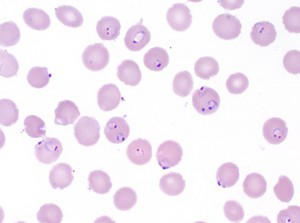Global burden of malaria infection and disease
Malaria is caused by a mosquito-transmitted protozoal infection. Although infection may be asymptomatic or cause minimal symptoms, when left untreated it may develop into a life-threatening illness and lead to death. In 2010, an estimated 216 million malaria cases occurred, primarily in sub-Saharan Africa (SSA), resulting in more than 650,000 deaths [1].
There are five species of malaria parasite that cause malaria in humans: P. falciparum, P. vivax, P. malariae, P. ovale and P. knowlesi. The most common species are P. falciparum and P. vivax, with P. falciparum being the most virulent; although there is increasing recognition of severe pathology associated with P. vivax infection. Persons with little or no immunity to malaria, such as young children or those infected for the first time, are at particularly high risk of developing severe symptoms and having poor health outcomes. Persons who are repeatedly infected with malaria may become partially immune and have minimal or no symptoms from the infection.

Heavy infection with malaria showing typical diagnostic characteristics of P. falciparum: small delicate intracellular ring forms, multiple rings in a single red blood cell (RBC), “head phone” appearance and “applique” forms (on the edge of the RBC). Photo courtesy of Bobbi Pritt, MD.
More information on the worldwide impact of malaria:
Refugees and malaria
Malaria infection is well described in certain refugee populations resettling in the US [2, 3, 4]. The epidemiology of infection in refugees tends to reflect the malaria dynamics in the area from which the refugees originated prior to resettlement. Therefore, refugees from sub-Saharan Africa (SSA) historically have the highest prevalence of infection, particularly of P. falciparum malaria. Infection with other species of malaria parasites is found predominantly in refugees from East Africa and in certain populations from South Asia such as refugees from Burma.
As resettlement of refugees from SSA increased during the late 1990s, so too did awareness of malaria and the number of documented malaria cases [2, 5]. Combined with mounting evidence that US providers were poorly equipped to recognize or properly treat malaria, the CDC recommended in 1999 for refugees originating from SSA to receive pre-departure presumptive treatment of sulfadoxine-pyrimethamine (SP), which is also known by its trade name Fansidar [5, 6, 7]. In 2007, due to drug resistance and documented failure of SP, the pre-departure presumptive treatment was changed to artemisinin-based combination therapy, which currently is a fixed combination of artemether-lumafantrine (AL). Information on current pre-departure malaria regimens being received by specific refugee populations is available from the CDC.
Learn more:
Contributed by William Stauffer M.D., M.S.P.H., University of Minnesota
References
1. World Health Organization. World Malaria Report, 2011. Available at: www.who.int/malaria/world_malaria_report_2011/en Accessed, Sept 9, 2012.
2. Slutsker L, Tipple M, Keane V, et al. Enhanced medical assessment strategy for Barawan Somali refugees—Kenya, 1997. Morbid Mortal Wkly Rep 1998;46:1250-1254.
3. Maroushek SR, Aguilar EF, Stauffer W, Abd-Alla MD. Malaria among refugee children at arrival in the United States.Pediatr Infect Dis J 2005; 24(5):450-2, 2005.
4. Ndao M, Bandyayera E, Kokoskin E, et al. Comparison of blood smear, antigen detection, and nested-PCR methods for screening refugees from regions where malaria is endemic after a malaria outbreak in Quebec, Canada. J Clin Microbiol 2004; 42:2694-700.
5. Slutsker L, Tipple M, Keane V, et al. Malaria in East African refugees resettling to the United States: Development of strategies to reduce the risk of imported malaria. J Infect Dis 1995;171(2):489-493.
6. Newman RD, Parise ME, Barber AM, Steketee RW. Malaria-related deaths among U.S. travelers, 1963-2001. Ann Intern Med 2004; 141:547-55.
7. Kain KC, Harrington MA, Tennyson S, Keystone JS. Imported malaria: prospective analysis of problems in diagnosis and management. Clin Infect Dis 1998;27:142-149.
